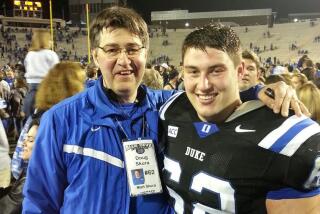The heartwrenching and uplifting tale of ‘Gleason’: From NFL hero to father to ALS soldier

The trailer for the new documentary “Gleason.”
A grueling recording session was inching along for former NFL player Steve Gleason.
Gleason, who is afflicted with ALS, is the subject of an eponymous documentary about his life, and he and pal/former New Orleans Saints teammate Scott Fujita were taping localized promos to attach to them. The Washington native is strictly confined to a wheelchair — it takes a staff of more than a half-dozen nearly two hours just to get him ready in the morning — and speaks by manipulating a robotic version of his voice with his eyes.
At a skyscraping suite in a downtown Los Angeles hotel, the promos rolled on as Gleason and Fujita patiently indulged a crew’s request to customize their message to different places — Georgia, Michigan, Ohio, Wisconsin.
Finally, Gleason, who had been silent for a little while, let loose a droll line.
“What about ‘America’?” he asked.
The moment captured the essence of Gleason, and “Gleason,” which at once conjures an unimaginable nightmare and an equally unthinkable reserve of strength and humor. You may watch a more important documentary this year. You almost certainly won’t see one as devastating or inspirational.
“Gleason” tells of a man who was an undersized defensive player with an unexpectedly long football career, largely on special teams, thanks to his scrappy style. He was canonized as a New Orleanian when he blocked a punt in the Saints’ first game back at the Superdome after Hurricane Katrina.
In 2011, several years after retirement, Gleason began experiencing neurological symptoms. Soon after, he received the diagnosis, which in a poignant turn was shortly followed by news that his wife Michel Varisco was pregnant. With the same can-do attitude he had as a player, Gleason picked up a video camera and began recording himself. As he notes in the film, he wants to “pass along” as much of himself as he can to his son.
“It looks like we’re not going to have the normal father-son relationship,” he says to his unborn child as his physical powers begin to ebb. “But I’m going to do everything I can to be a good father. ... It’s not gonna be easy. But it’s gonna be awesome.”
The movie then traces the thoughtfully salt-of-the-eart couple through the birth of their boy, Rivers, and the joys and struggle beyond. “Gleason” is about the relationship between fathers and sons (including Gleason’s embattled, at times heartbreaking relationship with his own dad); husbands and wives, and ultimately, between a man and himself.
As Gleason says when an embarrassing loss of body control shortly follows the dedication of a statue to him, “It’s an incredible example of the polarities, dichotomies and juxtapositions that is my life.
Beginning as a kind of homemade video scrapbook with the help of local filmmakers David Lee and Ty Minton-Small, the project soon accumulated 1,300 hours of footage. Those were then heavily shaped into a narrative by the documentarian Clay Tweel (“Finders Keepers”), credited as the director, and the filmmaker Seth Gordon (“Horrible Bosses”), who shares story credit with Tweel. (Fujita is among its producers.)
After gangbusters screenings at Sundance and SXSW, “Spotlight” studio Open Road releases “Gleason” in theaters Friday before Amazon makes it available this fall.
“ALS is not only a physical disease, but also an emotional one,” Gleason, 39, said in an email interview shortly after the promo session. “It takes an incredible commitment to live with the disease in every aspect. Some people call it strength, others say we’re being courageous, some even say crazy.”
Varisco said she’s still grappling with the reality of the couple’s existence.
“I miss him. He misses him. I miss his voice. He misses being able to move,” she said, exhaling as she took a rare breather in a hotel room near the promo shoot. “Our everyday life is hard a lot of the time.
“But I think for Steve the idea of this future being bigger than his past is true,” she continued. “He’s a purpose-driven human. And he’s doing greater things that he would have if he had not gotten the diagnosis.”
I think for Steve the idea of this future being bigger than his past is true. He’s a purpose-driven human.
— Michel Varisco
Gleason and Varisco had made the trip to a premiere in Los Angeles from their home in New Orleans. They had come via a special flight — Gleason is surrounded by a team that assists him with everything from wheelchair maintenance to clearing out his membranes because he can’t cough on his own--that costs tens of thousands of dollars.
The journey appears to have been worth the effort. At the premiere, Gleason was greeted with an extended standing ovation when he and his posse came out after the screening and Gleason haltingly but charmingly offered some remarks. The event was a kind of religious experience; total strangers stood up and began spontaneously calling out how inspired they felt, a reaction Fujita later said was common but no less surprising when it happened.
The film unvarnishedly shows the despair that can set in among those suffering with a terminal disease — in one scene Gleason communicates to Varisco how his days are unbearable and the nights are worse — providing a more human look at a story often told through glossily uplifting news segments and Make-A-Wish promotional videos.
Asked in the email about his state of mind now, Gleason expressed a resolute philosophy.
“There is no point in being angry about it or blaming anyone, or anything. I find it more powerful to focus on the things I can do rather than the things I can no longer do. Right now, I am as productive as I’ve ever been,” he said, also alluding to his foundation, Team Gleason, that among other services provides machines for ALS patients who can’t afford them. “I have an amazing family who help fill me with a continued sense of purpose and passion.”
SIGN UP for the free Indie Focus movies newsletter »
(The documentary does not much address what might have caused the disease in Gleason. The NIH and others have pointed to genetics but said physical trauma may be a contributing factor. At one point in the film Gleason’s father suggests repeated blows to the head playing football played a role. If the NFL sees the film as anything but a flattering portrayal, though, it isn’t letting on; the famously guarded league has allowed game footage to be used and even hosted a New York screening.)
But for all his seriousness, Gleason has also maintained a comedic streak. Clare Durrett, the star’s publicity aide de camp said, “It’s hard to know what he’s thinking, because it’s such a poker face. But then he comes out with something really funny.”
When asked in the email about the future, Gleason said, “Our foundation continues to work with leading minds in technology, and we believe we will continue to change how many live with physical limitations. My son is only 4, but his future excites me and I can’t wait to see who he grows into. Oh, and I still plan to go into outer space.”
On the day of the promos, the planning was slightly more mundane. The challenge was arranging logistics for Gleason and Varisco and Rivers, who would eventually all reconvene in Fujita’s house in Carmel, home base for a West Coast promotional tour. There is a kind of chaos to their planning, like a particularly dramatic version of those relatives who always seem to be figuring out pickups and dropoffs.
That, and so much else, could take its toll on Varisco, seen as a kind of free-spirit-turned-rock in the film.
She said she’d yet to explain everything to Rivers, referring to the premiere simply as “an event.” At 4 and without the hardened judgment of an adult, he seems unfazed by the idea of his father as an ALS patient, unflappably watching cartoons on the day of the promos. In the film he can be seen climbing in his dad’s chair like it’s any other kind of recliner and gleefully whizzing around a field pulled by Gleason’s wheelchair like a child going on a weekend sled ride.
He and his pre-school friends also like being read to by Gleason, because what child doesn’t like a man with seeming super-robotic abilities to read to them?
One of the film’s great moments, and its sharpest juxtaposition, comes at Rivers’ 1-year-old birthday party, when the infant is seen learning to eat while, in the same frame, Gleason increasingly needs help feeding himself. “Gleason” is, in a sense about a circle of life, one person coming to terms with what he can’t do anymore while another comes into his own.
With the promos done, Gleason was finally free to talk.
Asked how the last six months left him all feeling, he looked at the wheelchair-attached screen that controls his voice and said, “I would say it’s fun and exhausting.”
When pressed on what he’s taken from the period, Gleason paused for a second, then his eyes darted quickly in front of the screen. “It’s important,” he said, “for us to enjoy the journey.”
MORE FROM ENTERTAINMENT
‘Bad Moms’ and taking the shame out of motherhood on screen
Ted Sarandos says Netflix to spend more on original content
‘Stranger Things’ has big plans for a second season, if Netflix gives it the green light
More to Read
Only good movies
Get the Indie Focus newsletter, Mark Olsen's weekly guide to the world of cinema.
You may occasionally receive promotional content from the Los Angeles Times.











